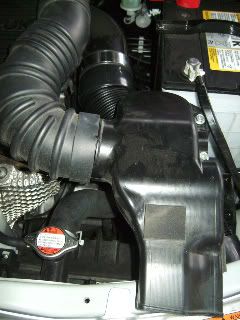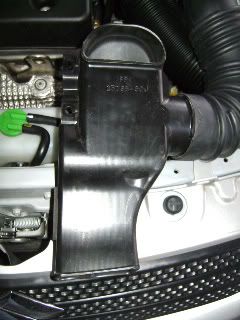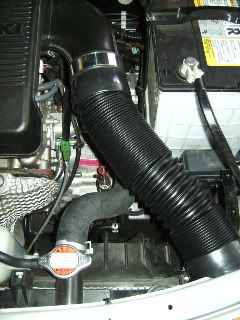 06-28-2008, 12:11 PM
06-28-2008, 12:11 PM
|
#11 (permalink)
|
|
Banned
Join Date: Feb 2008
Location: california
Posts: 1,329
Thanks: 24
Thanked 161 Times in 107 Posts
|
Quote:
Originally Posted by Vanner

Or what the article says, I didnt read it.
I made some pretty broad claims here, let me know if im wrong.
|
You should At least read the article. Auto speed has a series of articles on "eliminating negative boots" and "fordward facing intakes". They did the modification on a both NA and turbo cars including a honda Insight. Its all there.
As for my previous claim, I followed the Autospeed articles to the letter. i installed large sealed forward facing intakes on 3 cars. 2 volvos that originally had thermostatic variable hot/cold intakes, and 1 BMW that simply breathed all its air from inside the engine bay near the radiator. On the bmw i was able to to measure the temperature drop from 20-40f above ambient stock down to 0-5f above ambient.
http://www.matthewsvolvosite.com/airbox.php
M42club.com - Home of the BMW E30/E36 318i/iS - View Single Post - Looking for cold air intake
Quote:
Originally Posted by garys_1k

Reducing upstream restrictions just means you'll hold the throttle closed more, and increasing upstream restrictions means you'll hold the throttle open a bit more. The end result is the same.
|
No, thats not how it works. The engine will still breath the same ammount of air and have the same intake if you increase air pressure, reduce throttle angle and maintain the same load. Take the engine up to 30k feet where it can only produce 30% as much power at WOT and it will still consume the same amount of fuel at the same load.
[QUOTE=garys_1k;39268]
Quote:
Originally Posted by garys_1k

Back in my max. HP days I played with that sort of ram air, but just like the equations say, there's pitifully little pressure available from forward speed until you exceed about 90 mph. In any case, for hypermiling, it's a waste of time.
|
Read the autospeed articles. Its not about pressure, its about reducing restriction. The large forward facing intake improves fuel economy by making the engine a more efficient air pump at low RPM and high load. This will allow you to use 1 or 2 gears higher at any given load.
HAPPY READING
Eliminating Negative Boost - Part 1
http://www.autospeed.com/cms/A_0629/article.html
Eliminating Negative Boost - Part 2
http://www.autospeed.com/cms/A_0637/article.html
Eliminating Negative Boost - Part 3
http://www.autospeed.com/cms/A_0646/article.html
Eliminating Negative Boost - Part 4
http://www.autospeed.com/cms/A_0652/article.html
Eliminating Negative Boost - Part 5
http://www.autospeed.com/cms/A_0663/article.html
Negative Boost Revisited, Part 1
http://www.autospeed.com/cms/A_107824/article.html
Negative Boost Revisited, Part 2
http://www.autospeed.com/cms/A_107825/article.html
Negative Boost Revisited, Part 3
http://www.autospeed.com/cms/A_107826/article.html
Negative Boost Revisited, Part 4
http://www.autospeed.com/cms/A_107827/article.html
Negative Boost Revisited, Part 5
http://www.autospeed.com/cms/A_107828/article.html
Doing the Impossible
http://www.autospeed.com/A_109877/cms/article.html
Modifying the VL Turbo Intake
http://www.autospeed.com/cms/A_0779/article.html
Into the Intake - Part 1
http://www.autospeed.com/cms/A_1361/article.html
We Have a Record!
http://autospeed.com/cms/article.html?&A=109217
Last edited by tjts1; 06-28-2008 at 12:36 PM..
|
|
|

|
 Today Today
|
|
|
|
 Other popular topics in this forum...
Other popular topics in this forum...
|
|
|
|
 06-28-2008, 12:54 PM
06-28-2008, 12:54 PM
|
#12 (permalink)
|
|
Master EcoModder
Join Date: Apr 2008
Location: Earth
Posts: 303
Thanks: 0
Thanked 8 Times in 4 Posts
|
Hello, McFly? You have a throttle plate.
|
|
|

|
 06-28-2008, 01:51 PM
06-28-2008, 01:51 PM
|
#13 (permalink)
|
|
EcoModding Lurker
Join Date: Jun 2008
Location: Michigan
Posts: 76
Thanks: 0
Thanked 0 Times in 0 Posts
|
Thin air (hot, humid or altitude) will reduce engine maximum output and increase efficiency. It reduces pumping losses in the engine (but also reduces effective compression ratio) and it reduces wind resistance.
|
|
|

|
 06-28-2008, 02:12 PM
06-28-2008, 02:12 PM
|
#14 (permalink)
|
|
Banned
Join Date: Feb 2008
Location: california
Posts: 1,329
Thanks: 24
Thanked 161 Times in 107 Posts
|
Quote:
Originally Posted by jonr

Thin air (hot, humid or altitude) will reduce engine maximum output and increase efficiency. It reduces pumping losses in the engine (but also reduces effective compression ratio) and it reduces wind resistance.
|
No. You really need some data to back up that claim. Reducing the ambiant air pressure has exactly the same effect as closing off the throttle plate. There is no efficiency to be gained. But it does reduce aerodynamic air resistance for the vehicle body. |
|
|

|
 06-28-2008, 02:48 PM
06-28-2008, 02:48 PM
|
#15 (permalink)
|
|
EcoModding Lurker
Join Date: Mar 2008
Location: KY
Posts: 27
Thanks: 0
Thanked 0 Times in 0 Posts
|
Sorry I don't really know how to bring up them fancy quote boxes, but these are from tjts1:
"On the bmw i was able to to measure the temperature drop from 20-40f above ambient stock down to 0-5f above ambient."
Then we know your cold air works. It should decrease fuel economy for the reasons I listed above. Thanks for clearing up what you were talking about with the factory systems, btw.
"Read the autospeed articles. Its not about pressure, its about reducing restriction. The large forward facing intake improves fuel economy by making the engine a more efficient air pump at low RPM and high load. This will allow you to use 1 or 2 gears higher at any given load."
The exact opposite. At a given rpm, the load will be reduced, which is bad for engine efficiency. I understand it's not intuitive, but you have to realize that throttle plate is more than happy to compensate for any restriction you are able to reduce with a CAI/ram air/magic jelly beans whatever. Except, once again, at WOT. You are probably more efficient at WOT. In the second case, for a given load, the rpm will be reduced, which puts it farther out of the range of the next gear, not closer. Engines don't like lugging.
I hate to sound like I'm ganging up on you here, tj, but jon and garys are right. In your high-altitude example, that engine only produces 30% of its power because its only getting 30% of the mass of air it needs. Assuming the computer could compensate (which it most certainly could not) it would only use 30% of its regular load of fuel. The air/fuel ratio stays the same. Heck with no pumping losses it might even be more efficient. Imagine more on the order of 90% here and you have the concept behind a warm air intake.
__________________
1987 Chevy G20 high-top van - 305, TBI, 11MPG on its only trip 
|
|
|

|
 06-28-2008, 03:07 PM
06-28-2008, 03:07 PM
|
#16 (permalink)
|
|
Banned
Join Date: Feb 2008
Location: california
Posts: 1,329
Thanks: 24
Thanked 161 Times in 107 Posts
|
Well you have your point of view, I have mine. I installed large forward facing cold air intakes on 3 cars so far and all three had improved fuel economy after the modification. The autospeed tests on 5 different cars back up my real world experience. There is not much else I can add.
cheers
justin
|
|
|

|
 06-28-2008, 03:46 PM
06-28-2008, 03:46 PM
|
#17 (permalink)
|
|
EcoModding Lurker
Join Date: Mar 2008
Location: KY
Posts: 27
Thanks: 0
Thanked 0 Times in 0 Posts
|
I feel very argumentative at this point, but I finally flipped through the articles, and the author mentions fuel economy in only one sentence: a "gut feel" of "fractional" improvement that he himself admitted was "not very scientific." But that's fine, that's what I would expect from an article about improving performance from a magazine called autospeed.
As for your results (and the magazine's for that matter), I'm not saying they're inaccurate, but unfortunately there are dozens of variables affecting fuel economy. Outside temperature, the particular road used, speed traveled, weather, traffic, the driver, accessories, cetane/blend of fuel, other modifications done on the car at the same time as the CAI, and adaptations performed by the ECU could all have major, major effects on fuel economy between tests. With all other variables accounted for, I just simply do not understand how better economy is possible from a theoretical standpoint outside of the exceptions I presented above.
__________________
1987 Chevy G20 high-top van - 305, TBI, 11MPG on its only trip 
|
|
|

|
 06-28-2008, 04:05 PM
06-28-2008, 04:05 PM
|
#18 (permalink)
|
|
EcoModding Lurker
Join Date: May 2008
Location: Currently - Earth
Posts: 12
Thanks: 0
Thanked 0 Times in 0 Posts
|
I used "Spectre" pieces to modify the stock intake on both our SX4 and Caravan...
  
I've noticed both an HP increase and an improvement in mileage. I think a CAI type of intake is the most efficient way to go. |
|
|

|
 06-28-2008, 04:14 PM
06-28-2008, 04:14 PM
|
#19 (permalink)
|
|
EcoModding Lurker
Join Date: May 2008
Location: Motor City
Posts: 89
Thanks: 0
Thanked 1 Time in 1 Post
|
Quote:Originally Posted by garys_1k
Reducing upstream restrictions just means you'll hold the throttle closed more, and increasing upstream restrictions means you'll hold the throttle open a bit more. The end result is the same. No, thats not how it works. The engine will still breath the same ammount of air and have the same intake if you increase air pressure, reduce throttle angle and maintain the same load. Take the engine up to 30k feet where it can only produce 30% as much power at WOT and it will still consume the same amount of fuel at the same load.
Exactly, that demonstrates my point -- reducing restriction at one place (say, the air inlet system) and replacing it somewhere else (e.g. a more closed throttle valve, or high altitude) makes ZERO difference. We agree. Originally Posted by garys_1k
Back in my max. HP days I played with that sort of ram air, but just like the equations say, there's pitifully little pressure available from forward speed until you exceed about 90 mph. In any case, for hypermiling, it's a waste of time. Read the autospeed articles. Its not about pressure, its about reducing restriction. The large forward facing intake improves fuel economy by making the engine a more efficient air pump at low RPM and high load. This will allow you to use 1 or 2 gears higher at any given load.
Thanks, I did read them and am aware of how reducing pressure drop across the intake system can allow higher power via higher air mass flow. But when you're only asking for a relatively small fraction of the engine's peak torque (at its present speed) then those restrictions don't matter -- the total restriction, air system + throttle valve, do.
Getting good fuel economy is NOT about very high loads, it's about moderate loads at low-ish speeds. Lugging the holy hey out of an engine may seem to give great volumetric efficiency but the enrichment and spark retard will kill the overall efficiency. Most peak efficiency islands (BSFC) are about 2/3 or so of peak torque, maybe 3/4. Above that you get enrichment and spark retard, both FE killers.
The combustion chamber could care less what caused the particular mass of air to enter via the intake valve, throttle, dirty air filter or a piece of duct tape across the inlet pipe. All it "knows" is that there's a certain mass of air in there, plus a proportional amount of fuel, and when those are compressed they're burned and pressure is the result.
Low restriction air intakes are all about maximum torque. They won't let you upshift sooner at part pedal. In fact, given that pressure drop increases with velocity squared, they're biggest impact will be at high load at high engine speeds. Down in economy-RPM-land, like 1200-200 rpm, low restriction intakes are a total waste for fuel economy. Just keep the air filter reasonably clean and you're fine. |
|
|

|
 06-29-2008, 11:57 AM
06-29-2008, 11:57 AM
|
#20 (permalink)
|
|
Power tuner gone eco
Join Date: Jun 2008
Location: Alberta
Posts: 33
Thanks: 0
Thanked 1 Time in 1 Post
|
As a side note, I find it funny that Autospeed says the Insight intake is 'tiny' then say it's the lowest restriction ever at peak power.
That whole chart makes little sense as you have cars being tested at a few hundred horsepower, and the "lowest restriction ever" being tested at only 70ish hp.
So really, the Insight intake box is HUGE for 70hp, not tiny. And if you were to run the other cars at 70hp, it probably wouldn't be the lowest restriction intake ever anymore.
One comment on cold air intakes - vehicles with MAF sensors are particularly sensitive to how air goes over them. If you force air over a MAF sensor on the highway, the MAF tends to overcompensate and move up to higher load table in ecu and inject more fuel than is actually required for that load condition. I've seen drops on a GT time every time with any time of cold air intake that forced air over MAF. On really effective intakes, there was actually an accompanied drop in power as the vehicle ran too rich.
If you are going to do cold air on MAF sensor vehicle, I would put the intake 90 degrees to the air flow so as to not change air going over sensor.
I don't think low restriction is the only thing that Honda was aiming for, but my thinking goes into wave theory, length of intake track, etc.. gives me something to try, more than time to get into.
__________________
1992 - Suzuki Swift GT
|
|
|

|
|